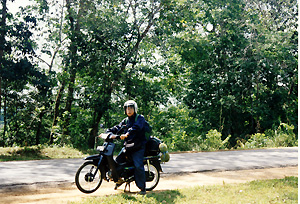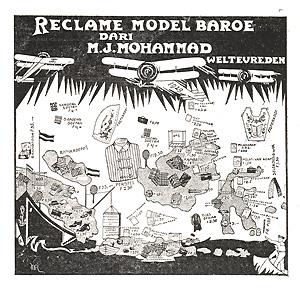 |
| Farewell group-photo with Tino Sanah in the front row, second from the left
(December 1990). |
 |
 |
| Researcher going back to Bukittinggi from fieldwork with fruits of research, durians
(December 1994). |
 |
One afternoon in December of 1984, I was chatting over tea in a Sumatran village in Indonesia. I asked my companion about rubber-tapping, the major livelihood of local men, and conditions of village life in general during the Dutch colonial period. Datuk Unut, the owner of the house where I stayed, thought back to the 1930s when he was a young and rising village merchant and rubber prices were once more increasing some years after the Great Depression. He said with a feeling, "It was an unusual and extravagant period. Even the old were rejuvenated!".
Starting in the year when the above conversation took place, I have visited the village of Koto Dalam practically every year, sometimes for one and a half months at any given visit but oftentimes for a shorter stay. Through the longitudinal study, I hope to observe and follow, as a more or less contemporary and in-situ eye-witness, social changes in Koto Dalam over the twenty-five years around the turn of the century and also to reconstruct a social history of the community which covers the greater part of the twentieth century.
The research project has haphazardly and gradually taken its present form despite the facade of good planning. In order to understand its origin and development, I have to tell a little bit about my research career.
After conducting sociological research on four villages in Sumatra for my dissertation in 1972-73 and, for a change, on migrant associations in Jakarta in 1980-81, I got stuck academically.
Fieldwork in a city was far more difficult than in a village and I was not sure what I would study next. That was the main reason why I was in Koto Dalam in 1984. I wanted to get back to village studies and see if anything interesting might turn up. I bought a motorcycle for the convenience of mobility and rode it around the countryside, visiting many villages and talking to village elders; this also had been my modus operandi during my previous research in Sumatra before I stumbled onto my dissertation topic. I spent six weeks in Koto Dalam because I wanted to re-immerse myself in village life. My academic sponsor at Riau University introduced me to Datuk Unut in his native village.
I still remember the date of what turned out to be the most fateful encounter in my personal and academic life. It was December 1st of 1984 that I met Tino Sanah, Datuk Unut's wife and my "femme fatale." Tino literally means "grandmother" and she was about sixty years old when I first met her.
In our everyday life, we get along with some people but not with others. Sociologists and anthropologists seldom admit it, but fieldwork replicates real life. For some reasons, I jibed with Koto Dalam right from the moment of setting foot there and took an immense liking of Tino Sanah who was short, slim, and exuberant with her "wo-fu-fu" laughter. She laughed this laughter because she liked betelchewing and often laughed with her mouth full of sirih (betel). It is a matter of only slight exaggeration if I say I ended up going back to Koto Dalam every year to see if Tino Sanah was doing fine and to listen to her old stories.
In Koto Dalam, I usually talk to village elders, asking their recollections of village life and its changes over the last several decades. I am hoping to reconstruct a "lived history" in a more nuanced way through interviews and plain chatting in addition to written documents.
For example, the following stories seem to show changing attitudes of the "locals" toward Europeans better than ordinary written history. Tino Gondi, one of the oldest women I met in Koto Dalam who remembered seeing the total eclipse observed in central Sumatra in 1901, once told me the impression when she saw a white man for the first time in her life. She said, "his nose was as big as half of his face and his skin reddish white." Her comment suggests to me that she found the white man very unattractive. This comment is very different from that of Tino Sanah, a few decades younger than Tino Gondi, who found a Dutch lady she saw as a girl attractive as "her nose was shaped like a pointed hood of a European car [old Chevrolet]."
Koto Dalam has no electricity or running water. An unpaved road finally reached it in 1998. What would a longitudinal, fixed-point study in a remote Sumatran village tell us? I hope it would tell us a great deal. Firstly, it hopefully will help us better understand the nature and direction of rapid and drastic changes many societies in Asia and Africa have been undergoing in the process of "development" in the last few decades. Secondly, I hope it will help us better empathize with the kind of experiences, encompassing their similarities as well as differences, our parents' and grandparents' generations, irrespective of their countries of origin, must have gone through during the course of the twentieth century. Koto Dalam to me is a window through which to gaze at a wider world.
Take a look at an advertisement published in an Indonesian magazine in Jakarta in 1929. We see here a tennis racket, bed, novels, football, pajamas, shoes, gramophone, hats, wristwatch, pencil, and so on seemingly raining down on the Dutch East Indies. And despite the lack of direct road connections, many of these western and "strange things" (barang ganjil) were already available in Koto Dalam during the 1930s. In this sense, Datuk Unut and Tino Sanah are very much contemporaries of my parents' generation. That is why I think stories of their life would have ramifying implications in understanding experiences of the twentieth century in general.
 |
| An advertisement of a "department
store" in Bintang Hindia (February
1929). |
 |
Datuk Unut unfortunately passed away in 1987 and Tino Sanah last May.
Yet, I plan to keep going back to Koto Dalam for several more years in the future. Come August this year, I will rent a motorcycle in Bukittinngi, the home base of my first fieldwork, and make a 1500 km round trip to Koto Dalam. Over the years, the trip has in many ways become a sort of pilgrimage, that is, traveling back to my graduate-student's days when I first started fieldwork in Sumatra in the early 1970s. I had little wealth and status, yet lots of hopes and energy then. It is as if I became rejuvenated every year even though the unusual and extravagant period in Koto Dalam disappeared a long time ago.
 Essays from the Field
Essays from the Field